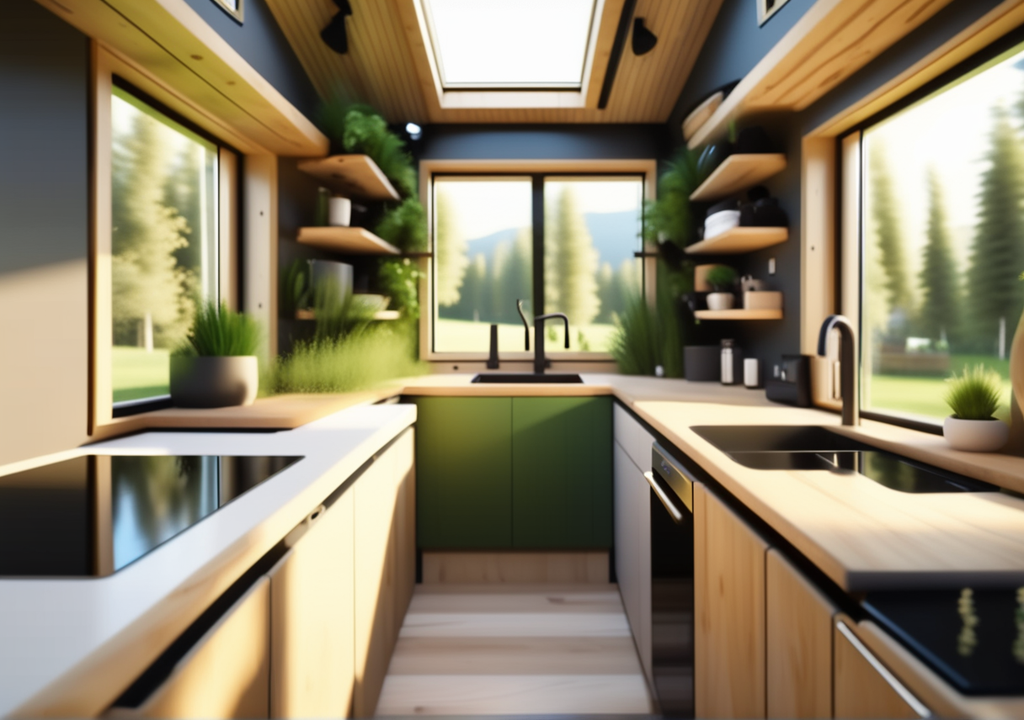Introduction
In an era of increasing environmental awareness, the popularity of tiny homes has soared due to their sustainable and eco-friendly nature. These compact dwellings offer a unique opportunity to live more consciously, with a smaller ecological footprint. By combining innovative design and eco-friendly features, tiny homes showcase how sustainable living can be achieved on a small scale. In this article, we will explore various eco-friendly features and practices that make tiny homes a beacon of environmental responsibility and showcase how living small can have a big positive impact on our planet.
1. Energy Efficiency
Energy-efficient design is a cornerstone of eco-friendly tiny homes. Careful consideration of insulation, windows, and materials plays a crucial role in minimizing energy consumption. High-quality insulation helps regulate indoor temperatures, reducing the need for heating and cooling. Utilizing energy-efficient windows and doors maximizes natural lighting and ventilation, further reducing reliance on artificial lighting and air conditioning.
Incorporating solar panels is a popular choice for generating renewable energy in tiny homes. These photovoltaic systems can power appliances, lighting, and other electrical needs, while surplus energy can be stored for later use. Additionally, using energy-efficient LED lighting, ENERGY STAR-rated appliances, and low-power electronics further contributes to reducing energy consumption.
2. Rainwater Harvesting
Innovative water management systems, such as rainwater harvesting, are prevalent in eco-friendly tiny homes. Collecting rainwater from the roof and storing it in tanks for later use reduces reliance on municipal water sources. This not only conserves water but also helps decrease the strain on local water supplies.
Rainwater can be used for various purposes, including watering the garden, flushing toilets, and general cleaning. Some advanced systems even filter and purify collected rainwater, making it safe for drinking and cooking. By integrating rainwater harvesting, tiny homeowners actively participate in water conservation and demonstrate responsible water usage.
3. Composting Toilets
Composting toilets offer a sustainable alternative to traditional flush toilets. These systems break down human waste and organic matter through natural processes, converting it into nutrient-rich compost. Composting toilets are waterless and odorless when correctly maintained, making them an ideal choice for tiny homes with limited water resources and off-grid capabilities.
Using composting toilets not only saves water but also diverts waste from landfills, reducing the environmental impact associated with sewage treatment. The resulting compost can be used to fertilize plants, closing the loop on waste management and contributing to a self-sustaining ecosystem.
4. Green Building Materials
Selecting eco-friendly building materials is vital in tiny home construction. Opt for sustainable and renewable materials like reclaimed wood, bamboo, cork, and recycled metal. These materials not only have a lower environmental impact but also add unique character and charm to the tiny home.
Avoiding harmful chemicals and volatile organic compounds (VOCs) in paints, adhesives, and finishes is essential for maintaining good indoor air quality. Using non-toxic and low-VOC products ensures a healthier living environment for tiny homeowners and contributes to the overall sustainability of the home.
5. Off-Grid Capabilities
Many tiny homes are designed to function off-grid, meaning they are not reliant on external utilities such as electricity and water supply. By embracing off-grid capabilities, tiny homeowners can achieve a higher degree of self-sufficiency and reduce their impact on natural resources.
Off-grid tiny homes often combine various sustainable features like solar power, rainwater harvesting, and composting toilets, enabling them to operate independently from traditional infrastructure. This self-reliance empowers tiny homeowners to live more sustainably, even in remote or environmentally sensitive locations.
6. Tiny House Farming and Gardening
Integrating farming and gardening practices into tiny homes enhances their eco-friendly nature. Utilizing small garden spaces for growing herbs, vegetables, and fruits not only provides fresh and organic produce but also promotes biodiversity and reduces the carbon footprint associated with commercial food production and transportation.
Tiny houses with enough outdoor space can explore micro-farming, keeping a small flock of chickens for eggs or maintaining a beehive for honey production. These practices contribute to local food security and foster a deeper connection with the natural world.
7. Passive Heating and Cooling
Passive heating and cooling strategies focus on harnessing natural elements to maintain comfortable indoor temperatures. Proper orientation and the strategic placement of windows allow tiny homes to capture solar heat during winter while minimizing heat gain in the summer.
Incorporating thermal mass, such as concrete or stone, helps absorb and store heat during the day, releasing it gradually at night when temperatures drop. Natural ventilation, aided by cross-ventilation and well-placed vents, facilitates airflow and cooling without the need for energy-consuming air conditioning.
8. Waste Reduction and Recycling
Tiny homeowners often adopt a zero-waste or low-waste lifestyle, which involves reducing waste generation and maximizing recycling efforts. Emphasis is placed on buying products with minimal packaging, reusing items whenever possible, and composting organic waste to avoid landfill contributions.
Tiny homes inherently encourage a more minimalist and mindful approach to consumption, as space constraints require careful consideration of every possession. By embracing a waste-conscious lifestyle, tiny homeowners set an example of responsible consumption for a sustainable future.
Conclusion
Eco-friendly features in tiny homes exemplify the marriage of innovative design and sustainable practices. From energy efficiency and rainwater harvesting to composting toilets and green building materials, tiny homes showcase how living small can have a positive impact on the environment.
These compact dwellings not only inspire more conscious living but also encourage a deeper connection with nature and a reevaluation of our material needs. By embracing eco-friendly practices in tiny homes, homeowners contribute to a more sustainable and resilient future while enjoying the simplicity and beauty of minimalist living. The movement towards tiny homes is a testament to the power of individual actions in shaping a greener and more environmentally responsible world.

